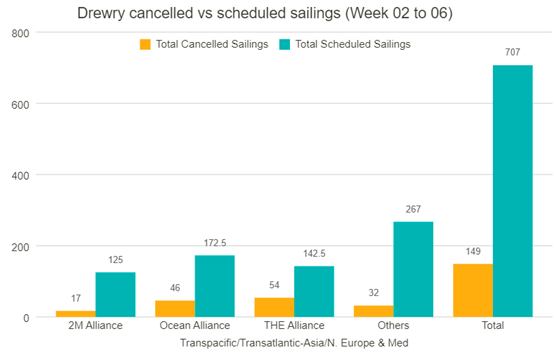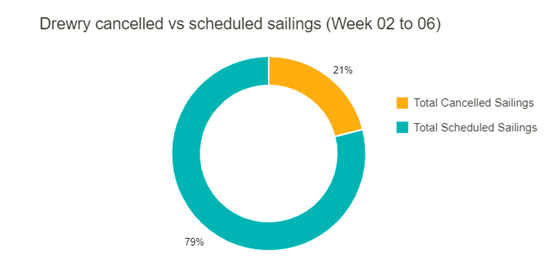Container marine market still not show positive signals
According to the indext from Drewry, the spot freight rates for containers from Asia to Northern Europe were up 10% to $1874/TEU compared with the level before the Christmas. However, demand for European exports has been much lower than usual ahead of the Chinese Lunar New year on January 22, and the freight rates are expected to be under pressure again after the Lunar New Year's holiday as carriers scrambled to increase the utilization rate of seats.
The container spot rate index on trans-Pacific routes was flat recently. For example, Freightos Baltic Exchange (FBX) rates from Asia to West and East America were virtually unchanged, at $1396/FEU and $2858/FEU respectively. Compared with Asia-Europe routes, carriers are generally more optimistic about the prospects for a recovery in demand for trans-Pacific routes, but the outlook after the Lunar New year remains uncertain.

The freight of major routes extended lower. The freight from Ningbo port to Brazil/NAV was near US$1300/40HQ, that to Bangladesh/Chittagong was near US$700/40HQ, that to Pakistan/Karachi was around US$700/40HQ, and that to Indonesia/Jakarta decreased to US$250-300/40HQ.
Remark: the freight of different ships and forwarders differs, and the above freight is only for reference.
| Route | Description |
| Europe and Mediterranean | Transportation demand recovered slowly after the New Year’s Day holiday but did not see small peak before the Spring Festival. The freight rate extended lower with unsatisfactory supply and demand. |
| North America | Transportation demand was soft and did not see minor peak before Spring Festival. The freight kept falling under modest market fundamentals. |
| Middle East | Supply exceeded demand on this route. The spot shipping booking price continued reducing and the decrement expanded. |
| Australia-New Zealand | Demand for various goods was feeble. Transportation demand grew limitedly before Spring Festival holiday. The freight rate kept decreasing with not good market fundamentals. |
The total capacity of the top 10 shipping companies in the world surged by 2.6 million TEU or 13%
Alphaliner data showed that during the three-year period from January 1, 2020 to January 1, 2023, the total capacity of the top ten container shipping companies increased by 2.6 million TEU, an increase of 13%.
Alphaliner recently released an overview of fleet changes in 2022, and the total market share of the top 10 shipping companies has remained stable, accounting for 85% of the global fleet, compared with 84% at the beginning of 2020. During the epidemic period, shipping companies made high profits and adopted different strategies, including actively expanding market share to maintain or even reduce capacity.
| Company | Status quo |
| MSC | It has become the world's largest shipping company since it overtook Maersk, with the largest increase in capacity, with an increase of 832000 TEU or 22% over the past three years. In 2022, MSC capacity grew by 7.5%, mainly through second-hand ship acquisitions. |
| CMA CGM | CMA CGM is currently the third largest container shipping company in the world, ranking fourth before the epidemic, and its capacity growth was second only to MSC. Over the past three years, capacity of CMA CGM has increased by 697000 TEU, or 26%, thanks in part to new ships ordered before the supercycle and delivered between 2020 and 2021, compared with a 7.1% increase in 2022. |
| HMM | It is the third largest shipping company in terms of capacity growth from 2020 to 2022, with an increase of 428000 TEU, rising from 10th in the world in January 2020 to the current eighth. Over the past three years, capacity has grown by 110% (from a relatively small base), the highest among the top 10 shipping companies. According to the Alphaliner report, most of its growth was completed in 2020, due to the delivery of 12 new ships and the return of nine vessels that cancelled charter contracts. HMM capacity growth stagnated in 2022 and fell 0.4% year-on-year. Evergreen Shipping is currently the sixth largest shipping company in the world, ranking seventh in 2020, with capacity growth of 30%, 385000 TEU during the supercycle, almost between 2021 and 2022. |
Freight rates collapsed, and the revenue of the three major shipping companies decreased on the year in Dec, 2022
| Revenue of three shipping companies still saw all-time high in 2022 | ||||
| Company | Revenue in December | MOM change | Revenue in 2022 | YOY change |
| Evergreen Shipping | NT $29.144 billion | -19.25% | NT $627.142 billion | -28.15% |
| Yangming Marine | NT $16.36 billion | -16.58% | NT $375.927 billion | 12.39% |
| Wanhai Shipping | NT $11.458 billion | -11.78% | NT $258.869 | 13.54% |
Set a record! 149 flights were suspended! The three major leagues accounted for 78.5%!
According to the latest Drewry data, of a total of 707 scheduled flights on major trade routes across the Pacific, transatlantic and Asia to Nordic and Mediterranean, 149 flights were cancelled in the five weeks from week 2 (January 9-15) to week 6 (February 6-12), accounting for 21% of the cancellation rate.


During this period, 58% of the suspensions occurred on the trans-Pacific eastbound route, 31% on the Asia-Nordic and Mediterranean route, and 11% on the transatlantic westbound trade route. In the next five weeks, the THE Alliance announced the cancellation of up to 54 flights, followed by the Ocean Alliance and the 2M Alliance, with 46 and 17 cancellations respectively. In the same period, non-shipping alliances implemented 32 suspensions.
Drewry said that before the Lunar New year (January 22), the pre-holiday freight peak did not arrive as scheduled, but the spot freight rate showed greater flexibility. The Drewry world container index this week showed that freight rates on routes from Shanghai to Rotterdam rose 10% month-on-month. However, as the market is expected to have excess capacity in 2023, carriers will continue to cancel more flights.
Views toward market outlook
1. 1/3 of the world's economies will be hit by a recession in 2023, while half of the EU's economies will fall into recession, IMF Managing Director Kristalina Georgieva warned. She said the new year would be "more difficult than the past year".
The IMF cut its global growth forecast for 2023 by 0.2 percentage points to 2.7 per cent, dragged down by geographical conflicts, inflationary pressures and continued interest rate hikes by major central banks such as the Federal Reserve. Among them, IMF lowered its 2023 GDP forecasts for the Euro zone, the UK and Latin America. China's GDP is expected to increase to 4.4% in 2023, and the economic growth of other countries in the world will slow down again.
2. Lars Jensen, chief executive of Vespucci Maritime, said that the rebound in orders would "depend on the depth and duration of the current economic downturn". "At best, this surge may occur in the peak season of 2023; in the worst case, it may be postponed until before the Lunar New year in early 2024." Jensen warned.
3. Shipping container leasing and trading platform Container xChange said in a report that freight rates in the container shipping market were falling sharply and will continue to reduce in 2023, and as the market faces a serious oversupply, shipping companies can only continue to reduce shipping capacity, suspend voyages, and the market faces huge fluctuations.
4. Sea-Intelligence, another shipping consultancy, through data analysis, although the container shipping companies were vigorously reducing capacity, but due to the upfront investment of too much capacity compared with the same period in 2019 before the outbreak, the market capacity will be significantly excess during the Chinese Lunar New year in 2023.
Among them, the capacity of the Asia-West America route increased by 37.8% over the same period in 2019 and 35.8% higher than the average capacity level in 2016-2019. The increase in capacity of the Asia-East America route advanced by as high as 57%-59%, and that of the Asia-Nordic route rose by 28%-42%. Only the capacity of the Asia-Mediterranean route was close to the pre-epidemic level.
Sea-Intelligence warned that container shipping companies had large amounts of cash and are highly profitable and could be caught up in a new price war.
The mainstream market players believe that freight rates will not stabilize until the global economy improves, the current destocking cycle ends, and consumer behavior returns to normal after the end of the epidemic.
- Top keywords
- Cotton Price
- Cotton Futures Price
- Cotton Futures
- CZCE
- PTA Futures Price
- Chemical Fiber
- Polyester Prices
- Wool price
- PTA Futures
- Shengze Silk
- China
- Yarn Price
- price
- China Textile City
- Fibre Price
- Benzene Price
- Cotton
- Index
- Cotton Index
- PTA
- fabric price
- NYMEX
- Top 10
- textile industry
- Spot Cotton
- Cotton Yarn
- Polyester Price
- Futures
- PTA Price
- cotton yarn price

